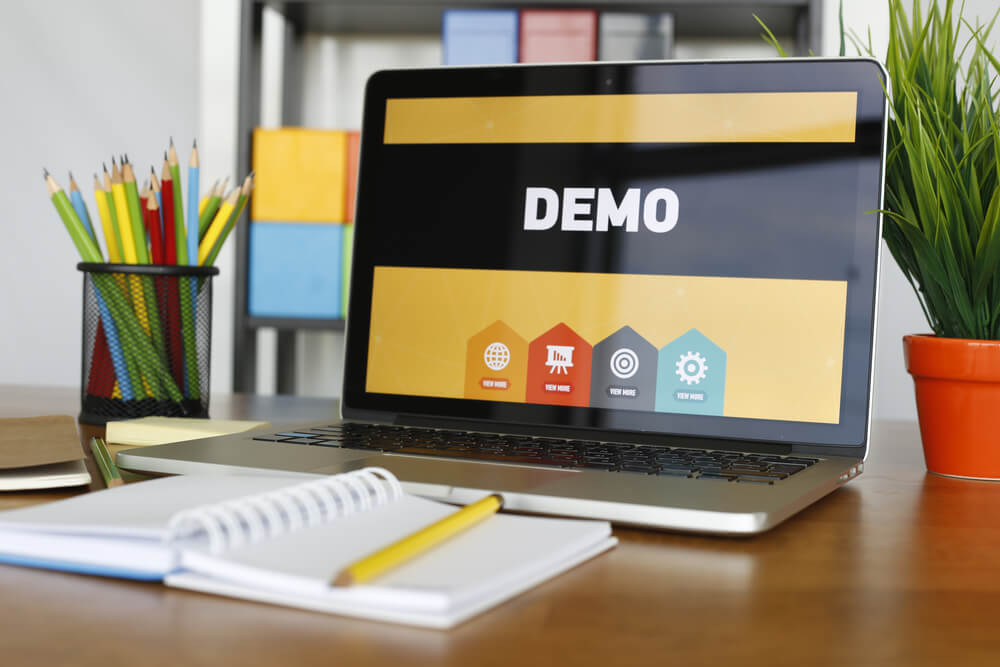
How Interactive Demos Engage Users & Increase Tech B2B Sales
Interactive demos are a game-changing tool in tech B2B sales. These presentations transform static, traditional sales pitches into hands-on experiences that captivate potential clients. The immersive product encounter accelerates sales by significantly influencing purchasing decisions.
This guide discusses the topic further. It provides an excellent overview of this emerging innovation with these points:
- Determining the appeal of business-to-business (B2B) interactive demos.
- Identifying best practices for creating effective demos.
- Measuring the success of interactive demos.
We have so much to cover. Let’s go!
We're the top B2B Content Marketing Agency in America. Watch the video below to learn why.
The Appeal of Interactive Demos in B2B Tech
Are your digital marketing efforts unsuccessful? Consider making the product experience more immersive. Besides creating conversational landing pages, use interactive demos to boost conversion.
Interactive demos appeal to the B2B market for the following reasons:
- Complex product understanding. B2B tech products often have intricate features and functionalities. Interactive demos simplify them, letting users understand challenging ideas at their own pace.
- Customization for various stakeholders. B2Bs can tailor experiences for diverse stakeholders. For example, they can address pain points specific to C-suite executives, IT professionals, and end users.
- Prompt problem-solving. Interactive demos demonstrate the product’s value in real time.
- Trust through transparency. B2B transactions rely heavily on trust. Interactive demos promote transparency with hands-on product exploration. It builds credibility because the market understands the product’s capabilities.
- Enhanced decision-making support. B2B buyers decide based on data. Interactive demos offer insight into user behavior and preferences, substantially shaping decision-making processes.
Leverage the power of interactive demos to engage users and drive sales by comparing them with traditional presentations below:
| Critical Feature/Experience | Interactive Demo | Traditional Sales Presentation/Static Demo |
|---|---|---|
| Engagement | An immersive experience where users interact directly with the product, driving engagement. | Passive experience, limited interaction. |
| Real-time Interaction | Users click, explore, and experience features firsthand in real time. | Users actively engage and explore functionalities. |
| Personalization | User experience customized to address specific pain points or showcase functionalities that align with diverse user needs and journeys. | Tailored experiences for diverse buyer personas. |
| Feedback | Provides instant feedback for prompt feature modifications. | Limited or no real-time feedback. |
| Hands-on Experience | Active product manipulation. | Observational, lacks hands-on exploration. |
Let us explore some of the points on the table further.
1. Enhancing User Engagement with Interactive Features
It is no secret that custom digital design influences user engagement and experience. So do interactive demos.
Interactive demos provide personalized journeys. The dynamic engagement and immediate feedback loops create an immersive experience that enhances product understanding.
Other reasons are the following:
- Immediate interaction. Interactive demos offer instant response, creating a seamless and engaging experience.
- Dynamic feedback loop. User interactions during the demo provide immediate feedback. It guides their exploration and creates a more engaging and tailored experience.
- Scenario-based simulations. Simulating real-life situations within the demo allows users to experience how the product addresses specific challenges.
- Interactive Q&A sections. Incorporating interactive Q&As enables users to seek immediate clarifications or delve deeper into functionalities.
- Tutorials and walkthroughs. Step-by-step guides or tutorials within the demo help users understand complex features. This ability increases engagement and ease of learning.
- Live data demonstrations. Demonstrating the product’s capabilities with real-time data builds trust and more clearly showcases its potential applications.
2. Building Product Understanding and Trust
Interactive demos are crucial in fostering brand trust and guiding users in the evaluation stages. The following points explain how:
- Provide interactive simulations and real-time experiences. The demos offer a firsthand encounter with the product’s functionalities. This deepens a person’s understanding of its potential.
- Allow users to customize and explore features. This ability empowers users to delve into specific aspects of the product. They gain insights into how it meets their needs and requirements.
- Emphasize use-case scenarios and practical applications. Interactive demos illustrate the product’s real-world relevance, practicality, and efficacy.
- Integrate comprehensive explanations. The structured demos help users to quickly comprehend the product’s complex features and functionalities.
Interactive demos are also invaluable in B2B sales when they act as problem solvers. They showcase how the product addresses the challenges potential buyers face.
In particular, they:
- Highlight specific features and functionalities. Interactive demos pinpoint distinct elements that directly solve B2B challenges.
- Tailor solutions for different business needs. These demos address the unique pain points of B2B stakeholders through customized solutions.
- Provide tangible proof of concept. Interactive demos instill product confidence by simulating how the technology directly resolves issues.
- Emphasize scalability and adaptability. You can demonstrate how the product supports customer growth.
3. Shortening the Sales Cycle
A tangible, immersive experience shortens the sales cycle. It addresses buyer queries, showcases product value, and swiftly instills confidence. It also streamlines decision-making by simplifying complex solutions and providing immediate feedback.
Streamlining a customer’s decision-making means seamlessly integrating interactive demos in marketing. Here are a few ideas:
- Customizing demos for different stakeholders. Customizing demos to stakeholders’ interests accelerates their decision-making.
- Using demos as follow-up tools. Employing demos as follow-up materials reinforces discussions. It quickens decision-making by reiterating key points.
- Leveraging demos in presentations and pitches. Integrating demos into presentations makes pitches more dynamic and engaging.
- Analyzing demo interactions. Data from demos enable sales teams to understand buyer behavior better.
4. Customizing Demos for Different Buyer Personas
Tailoring interactive demos to B2B buyer personas increases conversion because products become more relatable. It also deepens connections with stakeholders when solutions resonate with them.
Create customizable, impactful demos with these tips:
- Address specific pain points. Demonstrate the product’s relevance to the persona’s challenges.
- Highlight custom solutions. Showcase how the product solves a distinct need, underscoring its adaptability and value to diverse stakeholders.
- Adapt messaging and language. Match the demo’s tone to a targeted persona’s vocabulary and priority.
- Focus on use-case scenarios. Demonstrate the product’s practical applications by presenting relevant situations based on the lead’s industry or role.
- Personalize features and functionalities. Emphasize the product’s most beneficial features for a particular persona.
- Offer various navigation paths. Design personalized navigation to let stakeholders see the most relevant features.
- Collect persona-specific feedback. Use the data to fine-tune future presentations.
5. Gathering Valuable Feedback and Data
Interactive demos help acquire precise and nuanced B2B user insights. They transform into dynamic repositories of invaluable data by capturing granular details about user interactions, preferences, and engagement.
These tools also offer a comprehensive view of user behavior. They identify patterns, interests, and potential pain points.
Some tools that help you gather feedback for interactive demos are the following:
- Analytics tools. They provide quantifiable data for analysis within interactive demos. These include user interactions, engagement, and interests.
- Feedback forms and surveys. Incorporating feedback forms or surveys within demos enables direct user input. They capture their opinions and preferences that inform areas for improvement.
- Heatmaps and click tracking. Heatmaps and click tracking visually represent user interactions within the demo. They reveal popular sections and navigation paths.
- User-journey analysis. Analyzing the user journey informs how users navigate the product. It also enlightens you about user interests and pain points.
- A/B testing and experimentation. A/B tests compare user responses across different demo versions. The results optimize the presentation for better engagement and effectiveness.
6. Overcoming Sales Challenges
Interactive demos are potent tools to overcome prevalent sales challenges in B2B tech. They offer tangible solutions to issues. They also simplify complex technical concepts that mitigate skepticism.
Consider these real-life examples:
- Company X simplifies complex ideas with interactive demos during a tech expo. This decision increases its conversion by 30%.
- A SaaS company addresses technical concerns and showcases immediate solutions through interactive demos. This step reduces its sales cycle by 20%.
- Despite initial skepticism, a tech firm uses interactive demos to demonstrate its product’s real-time solutions. It leads to a 40% increase in initial client engagements.
- Company Y establishes client trust by offering interactive demos that simplify intricate solutions. It results in a 25% increase in client retention.
Best Practices for Creating Effective Demos

Creating effective interactive demos involves several best practices aimed at engaging users and driving B2B sales.
The following tips revolve around content clarity, seamless technical execution, user-centric design, and compelling storytelling:
- Ensure clear and concise content. Focusing on data that aligns with buyer interests fosters better understanding and engagement. It also avoids information overload.
- Optimize technical execution. Streamlining the demo’s navigation, functionality, and cross-device compatibility ensures a seamless user experience. It minimizes technical hiccups and enhances engagement.
- Design with users in mind. Developing intuitive, customized interfaces and functionalities prioritizes a user-centric experience. It boosts engagement and ease of interaction.
- Craft compelling narratives. Engaging stories around the product’s features and solutions captivate users. They make the demo memorable and effectively reinforce key points.
- Incorporate interactive elements. Integrating interactive elements, such as quizzes or personalized experiences, within the demo deepens engagement.
- Effectively visualize concepts. Engaging visuals, videos, and multimedia help effortlessly convey complex information.
Measuring the Success of Interactive Demos
Evaluating the effectiveness of interactive demos in driving revenue involves using specific tools and metrics. These include the following:
- Analytics platforms (e.g., Google Analytics). They track user behavior, engagement levels, and conversion rates within interactive demos.
- Clickthrough rates (CTRs). CTRs measure the effectiveness of calls to action. They also indicate user interest and willingness to explore further.
- Conversion rates. They provide a clear understanding of the demo’s impact on lead generation and sales.
- Session duration and interaction. The average session duration and user interaction levels measure lead engagement and interest.
- Feedback and surveys. Gathering feedback and conducting surveys post-demo enables businesses to collect direct user opinions and preferences. The data helps identify areas for improvement.
- Heatmaps and click tracking. Heatmaps and click-tracking tools visually represent user interactions within the demo. They highlight popular sections and navigation paths for deeper analysis.
- Lead conversion rates. Monitoring how the demo leads to actual sales or qualified prospects measures its effectiveness in driving conversions.
- Retention rates. Tracking retention indicates the demo’s impact on maintaining user interest in the product.
- Return on investment (ROI) and cost per conversion. They tell you the demo’s effect on the company’s bottom line.
Summing Up
How can the insights gathered from interactive demos shape future product development and marketing efforts?
They are invaluable guides in refining sales strategies. They help you align the product with customer needs and amplify engagement and conversion through more targeted campaigns.
Integrating interactive demos strategically enriches the sales process and serves as a wellspring of actionable data. The information shapes the future trajectory of B2B tech products and marketing.
Contact Digital Authority Partners (DAP) to know how interactive demos revolutionize your B2B sales strategy.
Want To Meet Our Expert Team?
Book a meeting directly here



